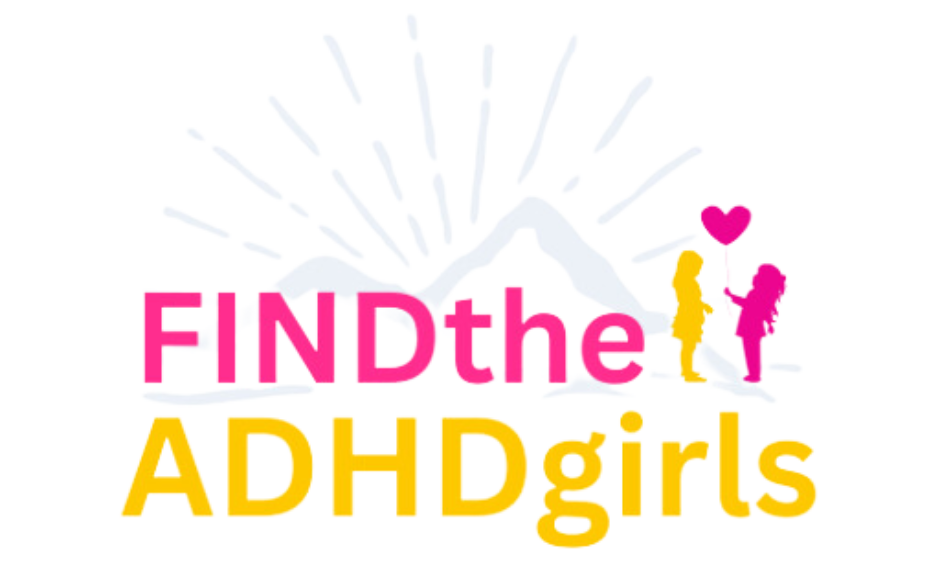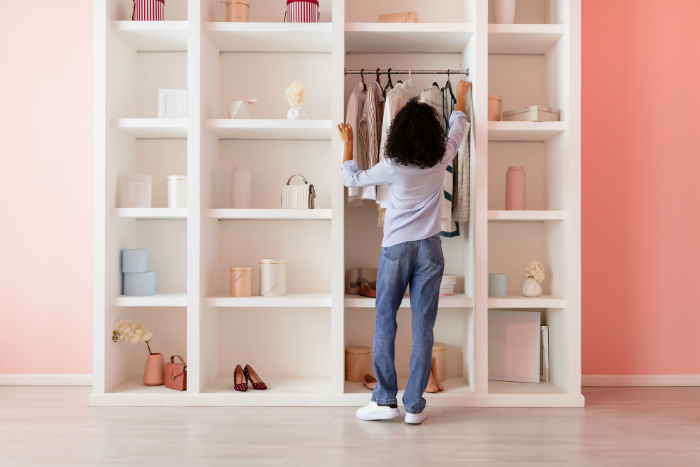Mornings in an ADHD-Friendly Home with ADHD girls are chaotic. Picture it: you ask your daughter to get dressed for school, but she MUST tell you about her dream last night—RIGHT NOW. Later, she abruptly leaves the breakfast table because her sticker book is in her room. She needs it before she can finish her cereal. Then you have to remind her three times to brush her teeth. Finally, she’s ready, but when you’re halfway out the door, she realizes she forgot her backpack.
Sound familiar?
Life with your ADHD daughter is a whirlwind. She’s creative, busy, lost in her thoughts, and constantly on the hunt for something she’s misplaced. You need a healthy dose of patience, resilience, and a great sense of humor to survive. Another lost sock? Brilliant. She’s trying her best, but the world just isn’t built for how her brain works.
However, you can support her by making your home more ADHD-friendly. Of course, this won’t magically make mornings a breeze or mean no more lost socks. But an ADHD-friendly home reduces friction between you and your daughter. She is less frustrated, tasks become more manageable, and she feels more independent and in control.
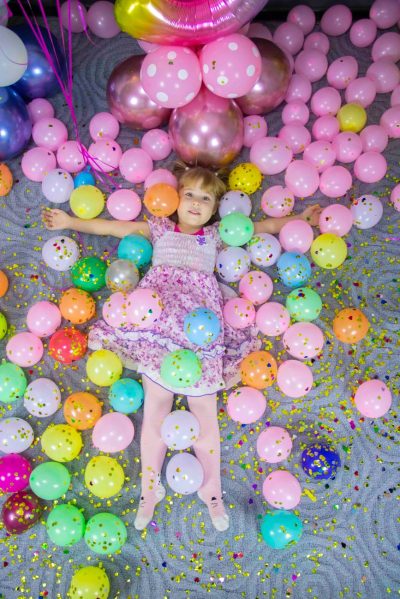
Why Tidiness and Organization Are Hard for Girls with ADHD
It seems like a no-brainer—how hard is it to put things back where they belong? But your daughter won’t do that! Her stuff ends up everywhere. Think about your daughter’s room, backpack, and play area. Is it cluttered and chaotic? The spaces of most girls with ADHD are. It’s executive dysfunction at its messy best.
“It takes me a lot more focus to do simple organizational things, and it makes my brain work a lot harder.”
~ Jessica, (pseudonym) ADHD survey participant
Executive Dysfunction
Girls with ADHD have impaired executive functioning, the skills you use every day to help plan, prioritize, organize, and start tasks. Let’s look at how her executive functioning difficulties impact her organizational abilities.
Prioritizing: You ask your daughter to clean up her room, and thirty minutes later, you find her reorganizing her shelves and sorting her books by size. Her bed is still unmade, clothes are everywhere, and toys are scattered around the floor. She doesn’t realize that sorting books isn’t a priority and gets distracted from the bigger picture of cleaning her room.
Timing: Girls with ADHD have trouble with time management and often try to do too much in too little time. They don’t know how much time to give themselves to do certain things. In short, your daughter doesn’t comprehend the passage of time with what she’s doing. And her task completion reflects it.
Focus: Attention deficit is misleading. Your daughter can focus, no problem. The problem is that she has an interest-driven brain. In other words, she’s liable to get distracted during a task and do something she finds more interesting. How often have you asked her to pick up her toys, only to find her playing with them instead?
Task initiation: Your daughter has trouble with task initiation. Sometimes, it seems like she’s being deliberately lazy or rebellious. You’ve asked her to do something 10 times. Why doesn’t she do it? But she has difficulty getting started, especially when a task seems complicated or boring.
Following multiple steps: She has trouble following multi-step tasks. She’ll forget steps or mess up the order and struggle to follow more than one instruction at a time. For example, if you say, “Make your bed, fold your clothes, pick up your toys, and put your shoes away.” It’s not getting done. It’s too much information all at once and doesn’t stick.
Transitioning: Executive dysfunction makes transitions difficult, i.e., switching from one task to another. Your daughter may make her bed but then get stuck. She doesn’t shift to the next task, like folding her clothes.
Self-regulating and controlling impulses: Your daughter struggles to stay on task, especially when it isn’t something she’s excited about, such as cleaning. It can feel impossible. Her brain is different from other children’s and she has less impulse control. So, Instead of pushing through and doing the task, your daughter may give up in frustration and do something else, like draw or read.
Making decisions: Decision-making is also hard. Especially when there are a lot of options. Your daughter struggles to process information effectively, so even small decisions can be mentally exhausting.
ADHD-Friendly Cleaning and Organizing
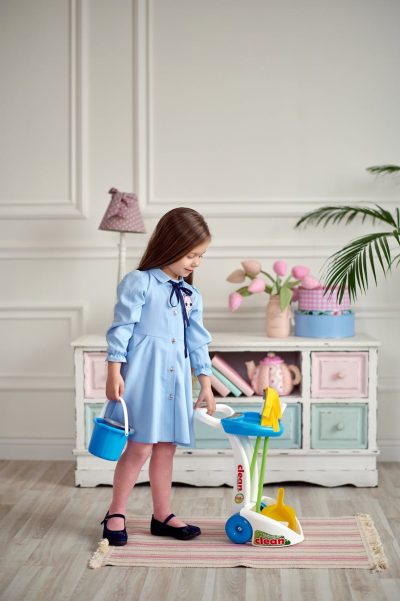
These executive dysfunction challenges lead to chaos, disorganization, and messiness. But girls with ADHD thrive in a clutter-free, organized environment. So, how do you set your daughter up for success?
Downsize First:
Downsizing is necessary but often easier said than done. Many girls with ADHD have a habit of storing little things, like bits and bobs, glitter, feathers, beads, and rocks. You name it, she has a pile of it. You want to get rid of the piles, but she doesn’t want to get rid of her “treasures.” That jigsaw puzzle that’s been gathering dust in a corner for 2 years? When it’s time to get rid of it, you can bet she was “just about to do that!” But it’s a simple equation: less stuff equals less clutter. Organization is easier, and she’s less likely to lose things.
How to Get Your ADHD Daughter’s Buy-In for Downsizing and Decluttering
Find a box for donations and talk to your daughter about giving her items new life by giving them away. Help her imagine her old toys on a new adventure, cherished by another little girl. Let her know you’re proud of her for helping other kids.
You can also create a one-in, one-out rule. Before your daughter gets a new toy or game, she has to get rid of an old one. This can serve as a reward for decluttering without adding more to the clutter!
Now It’s Time to Organize
Once you’ve helped her eliminate extra things she no longer uses, it’s time to get organized. That old saying, “A place for everything, and everything in its place,” applies here, but keep it simple! The simpler and easier something is for her to do, the more likely she is to do it.

Designate Specific Areas for Items and Activities
Drop zones and one-task zones are areas in your home with specific purposes. They help ease transitions and reduce frustration and lost items. So, create a place where your daughter can leave the essential items she uses daily. Then, she can easily find them later. All you need is a little space for her backpack, a clear bin for shoes, and a wall hook. When she gets home from school, she can drop her stuff and hang up her jacket in seconds. Simple!
ADHD Storage Solutions: Clear, Accessible, Customizable
You’ll also need somewhere to store and organize her items—the stuff she doesn’t use daily. Think modular shelving, movable bins, and adjustable storage space. This way, the shelving and storage can grow with her.
Work with your daughter to create a storage solution she’ll actually use. After all, this is for her. Allow her to choose which colors she’d like or select stickers for different bins.
- Clear storage bins: ADHD gives new meaning to the phrase “out of sight, out of mind .” If your daughter doesn’t see it, to her, it doesn’t exist. Clear bins give visual cues and improve her working memory.
- Color coding and labeling: Color coding encourages your daughter to organize things. Is her favorite color pink? Her toys go in the bins with a pink label, etc. These visual cues help her remember what goes where and develop her independence and task initiation because she knows exactly where things go.
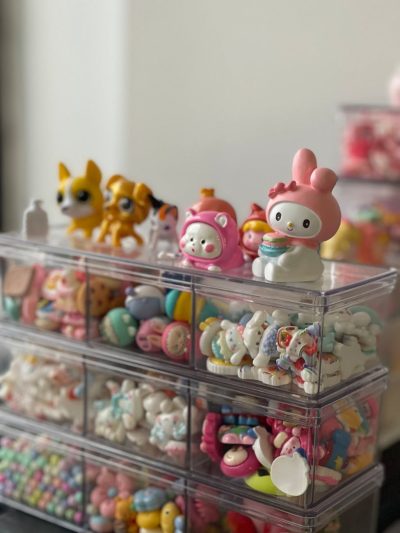
“If I said, “clean your room,” that wasn’t gonna work. I learned to say, “Clean your desk off, or clean your nightstand off, or put your clothes in the hamper”—very specific tasks.”
~Dr. Kristin Wilcox, PhD, ADHD author, mother of an ADHD child
So, you have less clutter and new storage; now what? It’s time to help your daughter learn how to organize and use the system. She needs help managing her executive dysfunction and working with her unique brain, which seeks novelty and dopamine. She isn’t rebellious or contrary when she doesn’t start or finish tasks; her brain is wired differently. So, to get your daughter’s participation –without a major struggle–make it interesting. Here’s how you can help her learn to clean her space and stay on task.
- Make it fun: You can turn cleaning and organizing into a game. For example, instead of saying, “Pick up your toys,” ask your daughter to sort them as she goes: stuffed animals in one area, dolls in another, etc. It’s a small change that lights up the interest area in her brain. Make it fun, and she gets it done!
- Time it: Your daughter can do anything in the world—5 minutes at a time. And you can work with that. For instance, ask your daughter if she can get all your toys in the bin in under 5 minutes? Then, repeat with another task, like asking how many of her clothes she can fold in 5 minutes. Competition, even against herself, is a great way to interest your daughter and get her participation.
- Break down big tasks: Task initiation and prioritization are hard for your daughter, and she might struggle to begin working. Put another way, a task can seem so big or overwhelming that she doesn’t start at all. But breaking down a big task into smaller ones can make beginning seem more manageable.
- One instruction at a time: Give one clear instruction at a time, like,” Make your bed.” Once that task is completed, give her another one. Following instructions one at a time supports her executive functioning and helps her stay on task.
It’s not that kids with ADHD can’t pay attention. Rather, it is inordinately difficult for them to make themselves pay attention when they don’t want to.
~Peg Dawson, Ed.D.
How to Keep Your Home Running Smoothly
Schedules and Reminders and Routines
Girls with ADHD thrive with structure, but they aren’t able to create that for themselves. They need your help to put schedules and routines in place. That structure reduces anxiety, supports executive functioning, and smooth transitions. And it’s easier than you think.
How You Can Help Your ADHD Daughter With Her Routine
Visual cues: Use visible reminders for routine tasks, such as getting ready for school in the morning or going to bed at night. It doesn’t matter if it’s something your daughter does daily; she can still forget or get distracted and miss steps. A simple visual reminder prompts her memory.
Checklists: You can also use charts or checklists for responsibilities and chores. Having a checklist or pictures helps your daughter stay on track and independent.
Anchor routines: Connecting existing habits and routines to each other is called anchoring routines. For example, after brushing her teeth in the evening, she should put on her pajamas. Grouping tasks together jogs her memory.
Timers: Using alerts and timers helps your daughter prepare for transitions and develop an understanding of how time passes. The Pomodoro technique is especially useful to help her focus and avoid overwhelm. All you need is a timer. Here’s how it works:
- Set the timer for 25 minutes (you can adjust it for your daughter, i.e., 15 minutes)
- Work on the designated task until the timer goes off.
- Take a 5-minute break, and then repeat.
This provides structure and sets expectations. And it’s an effective time management technique your daughter can use into adulthood.
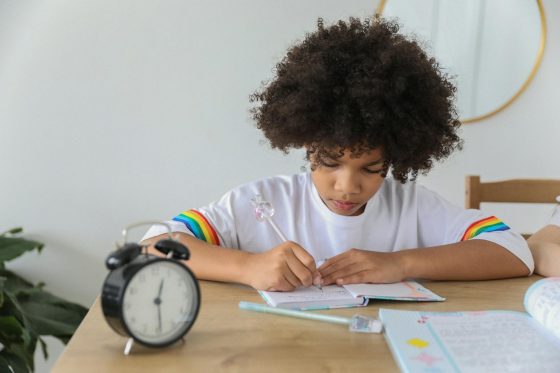
Keep The Momentum Going
Once you’ve slowly implemented these ADHD-friendly measures, maintain them! Check in with your daughter regularly. What’s working? What’s not working? Adjust routines and storage areas as you go so they work for her. Consistency is key, but be flexible. Tailoring organization and routines to your daughter’s unique needs will keep you moving forward, regardless of what systems you use.
Finally, an ADHD-Friendly Home
Creating an ADHD-friendly home doesn’t eliminate every challenge, mess, or lost belonging. But it reduces stress and helps your daughter develop independence and feel capable. She learns how her brain works and what helps her function at her best. Your help and support make a huge difference. Although it may take some trial and error, you can create a home that supports your daughter and helps her thrive!
For more information about an ADHD-friendly home, check out how to build an ADHD calm corner.
Co-Authors
 Alex Alcon
Alex Alcon
Alex Alcon, RN, Freelance nurse content and copywriter, owner of RN2Pen LLC
 Cynthia Hammer, MSW
Cynthia Hammer, MSW
Cynthia Hammer, MSW, is an ADHD advocate helping girls get timely diagnoses. She’s the founder of FINDtheADHDgirls, Executive Director of the Inattentive ADHD Coalition, and author of Living with Inattentive ADHD.
Share via:
